Winter Weather Safety for Pets

Living in Wisconsin brings pet owners a few challenges during the blistery winter months. How do we keep our pets safe while keeping them active and enjoying the outdoors? Here are a few tips to consider this winter.
A great rule to live by – if you are cold, they are probably cold as well. The breed, coat type, weight and age of your dog all play a factor in how the weather affects them.
Below 45 degrees – your pet will be cold but it is toler- able
Below 32 degrees – is risky for small animals, senior dogs and those with health problems
Below 20 degrees – unsafe depending on breed, keep time outside less than 20 minutes 10 degrees and below – avoid prolonged activity and consider the cold very dangerous
What are Signs of Hypothermia in Pets?
Hypothermia hits when the body temperature is lower than normal, which can cause damage and be fatal to our pets. Signs of hypothermia in pets include pale gums, shivering, lethargy, muscle stiffness and difficulty breath- ing. If you suspect hypothermia, begin to warm your pet.
Think ‘warm’ not ‘hot’. Get them to a warm and dry place, wrap your pet in a blanket or towel, and place warm bottles of water next to them. Immediately call your vet for additional instructions.
What Outdoor Gear is Appropriate?
As humans we wear extra layers, so why not consider these for our pets? Pets with short coats will get colder faster, look for a coat or turtleneck sweater that goes from neck to tail and under their belly. Booties are great for protecting paws from ice damage and to avoid chemicals on the ground, or massage petroleum jelly onto the paws to protect from salts on the ground.
5 Quick Tips:
- Leave your pet at home instead of taking them with you to run errands. If they will need to stay in the vehicle, your car can hold in the cold like a refrigerator.
- Sometimes additional calories are needed as your pet will burn more calories in the winter while trying to stay warm, consider feeding a little extra in the colder months.
- Wash your pet less during cold weather as bathing can remove oils, and potentially cause dry skin.
- Ensure your pet is drinking plenty of water as this will keep them hydrated and help with dry winter skin.
- Wipe your pets’ paws when they come indoors to dry them off, remove any chemicals like salt or deicers, and check for injuries like cracked pads.
Always consult your vet with any concerns about your pet.
Share this resource
[addtoany]Contact Us
Whether you’re looking to adopt, volunteer or simply want to chat about your love for animals, we’re all ears (and paws). Contact us today!





